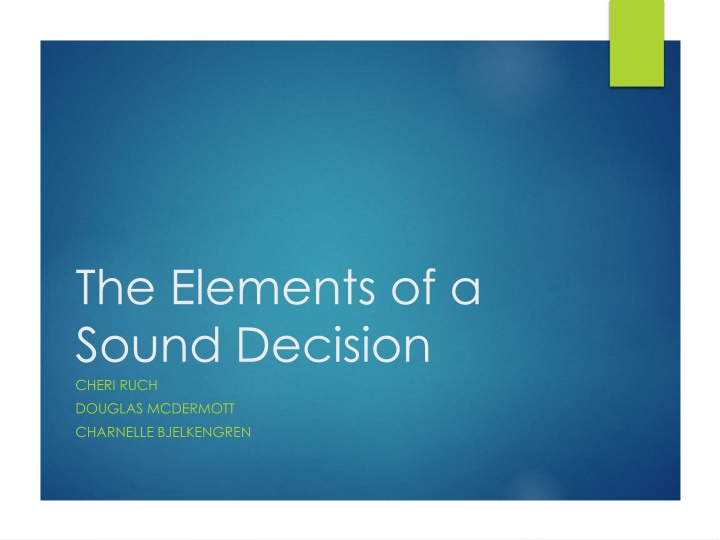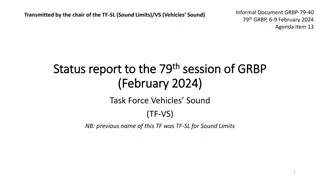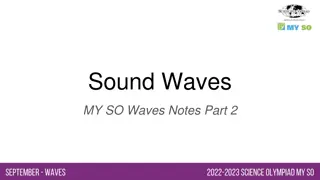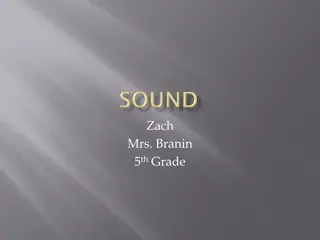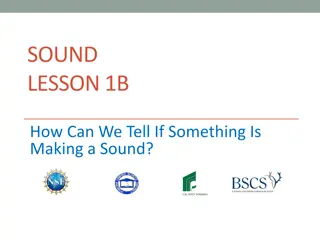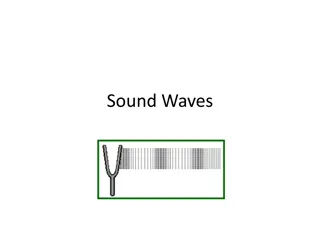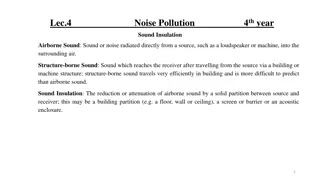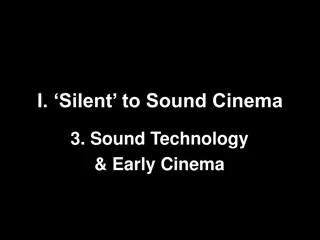Elements of a Sound Decision
This informative content outlines key aspects of making a sound decision, including reducing evidence to findings of fact, stating issue statements clearly, ensuring accurate findings of fact, and providing examples like voluntary quits and misconduct.
Download Presentation

Please find below an Image/Link to download the presentation.
The content on the website is provided AS IS for your information and personal use only. It may not be sold, licensed, or shared on other websites without obtaining consent from the author.If you encounter any issues during the download, it is possible that the publisher has removed the file from their server.
You are allowed to download the files provided on this website for personal or commercial use, subject to the condition that they are used lawfully. All files are the property of their respective owners.
The content on the website is provided AS IS for your information and personal use only. It may not be sold, licensed, or shared on other websites without obtaining consent from the author.
E N D
Presentation Transcript
The Elements of a Sound Decision CHERI RUCH DOUGLAS MCDERMOTT CHARNELLE BJELKENGREN
Overview Issue Statement 1. Reducing the Evidence to Findings of Fact 2. Conclusions of Law 3. Decretal 4.
Issue Statement Preferably located at the beginning of the decision Use concise, clear, and plainly stated language Should include all elements of the applicable statutory provisions, but need not be in the precise language of the statute
Issue Statement Example: Whether the claimant had good cause for quitting under RCW 50.20.050(2)(b)(i), or was discharged for misconduct as defined in RCW 50.04.294.
Findings of Fact Criteria 26 is a Critical Fair Hearing and Due Process element. Findings of Fact must be accurate, clearly stated, material, and relevant. Findings of Fact should be expressed in logical order (usually chronologically)
Findings of Fact Any of the following mistakes will result in a failing score for this criteria: Necessary findings of fact are omitted. The majority of facts are a recitation of the testimony. Findings do not accurately reflect the hearing record.
Findings of Fact Must include all findings necessary to resolve the issues and support the conclusions of law
Examples 1. Voluntary Quit a. Bona fide offer of employment Definite offer of employment i. Reasonable basis for believing that person had authority to make the offer ii. Specific start date iii. Agreed terms and conditions iv.
Examples Continued in previous employment for as long as was reasonably consistent with whatever arrangements were necessary to start the new job v. Covered employment under Revised Code of Washington Title 50 v.
Examples Misconduct 2. Nature of misconduct a. Prior warnings, who gave the warnings, reason for the warnings, dates of warnings, and types of warnings (written or verbal). b.
Examples Overpayments 3. Amount of benefits paid each week a. Regular or conditional b. Dates of any employment and wages earned each week c. Amount of overpayment d. Fault and Waiver e.
Credibility Finding of Fact: The parties testimony conflicted regarding the manner in which the job ended. In resolving this conflict, the attitude, demeanor, capacity for candor, and motivation of the witnesses was considered. The totality of the circumstances and the logical persuasiveness of the parties respective positions in light of those total circumstances were also considered. The testimony offered by AAAAA was more credible than the testimony offered by the BBBBB. Based on this finding, further findings of fact are set forth below.
Credibility Conclusion of Law: As stated in the Findings of Fact, the testimony offered by AAAAA regarding the manner in which the job ended is more logically persuasive than BBBBB s. In entering that finding I need not be persuaded beyond a reasonable doubt as to the true state of affairs, nor must the persuasive evidence be clear, cogent, and convincing. I only need to determine what most likely happened. In re Murphy, Empl. Sec. Comm r Dec. 2d 750 (1984).
Example I Evidence Written Policy requires an employee to call a supervisor at least 2 hours before the start of a shift in the event of an absence or tardiness. Parties agree that employees often use text messages to communicate with supervisors. Claimant testified, I texted my supervisor at 8:00 p.m. the night before my 6:00 a.m. shift that my child was sick and I would not be at work. Supervisor testified, Claimant did not call me. I never received a text message. When Claimant did not show up, I reported to H.R. that Claimant was a no call, no show. Employer discharged Claimant for a second instance of no call, no show within 6 months. 1. 2. 3. 4. 5. WHAT ARE THE FINDINGS OF FACT?
Example I Findings Evidence Findings of Fact In the event that an employee cannot report to work as scheduled, Employer s policy requires the employee to call the supervisor at least 2 hours before the start of the shift. 1. Written Policy requires an employee to call a supervisor at least 2 hours before the start of a shift in the event of an absence or tardiness. 1. Parties agree that employees often use text messages to communicate with supervisors. 2. Although Employer s policy is silent on the use of text messages, employees often use them to communicate with their supervisors. 2. Claimant testified, I texted my supervisor at 8:00 p.m. on Tuesday before my 6:00 a.m. shift that my child was sick and I would not be at work. 3. Claimant s child became ill on Tuesday evening. Claimant sent the supervisor a text message about 8:00 p.m. However, Claimant did not call the supervisor before the start of the shift on Wednesday. 3. Supervisor testified, Claimant did not call me. I never received a text message. When Claimant did not show up, I reported to H.R. that Claimant was a no call, no show. 4. The supervisor did not receive Claimant s text message. 4. The supervisor had disciplined Claimant for an instance of no call, no show within six months. 5. Neither party provided evidence of the text message traffic for the record. 5. Employer discharged Claimant for a second instance of no call, no show within 6 months. 6. Employer discharged Claimant for a second instance of no call, no show. 6.
Example I Explain Credibility in the Discussion Although Claimant maintains that she sent her supervisor a text message notifying him of her upcoming absence, the supervisor denies he received it. Claimant did not provide evidence of the text message traffic from her phone to support her assertion.
Example II Evidence Employer has a civility policy requiring written complaints of harassing behavior be filed with the designated human resources officer. 1. Claimant testified, My older male coworker commented about my attire almost every day. He told me how much he liked my long legs and how my skirts and heels showed them off. He made me very uncomfortable the way he leered at me. I told him to stop, but he did not. I complained to my supervisor, but he told me to ignore it and focus on my work. Everyone in my department knew about it, but no one would deal with it. I did not file a written complaint because I did not think it would do any good. I was getting migraines from the stress. I had to quit. 2. Claimant s supervisor testified, Claimant was at the fax machine when I walked by. She mentioned that her coworker had complemented her on her attire and she did not think it was appropriate. I told her to ignore it, but if it happened again, she should file a written complaint with human resources per policy. I didn t hear anything else about it, so I assumed that the matter was resolved. 3. The human resources office testified, Claimant never filed a complaint. Had she filed one, I would have investigated and recommended action. We do not tolerate the behavior Claimant described. I can t do anything without a written complaint. 4. Claimant sent her supervisor a text message stating that she was quitting immediately because she had found another job. 5. Claimant testified, I did not have another job. I did not want to deal with it anymore. I had to quit. If they would not take care of the problem while I was there, I saw no reason to tell them it was the reason why I was quitting. 6.
Example II Findings of Fact Employer has a civility policy. Employer s policy requires written complaints of harassing behavior be filed with the designated human resources officer. An older male coworker repeatedly commented about Claimant s attire . Claimant told him to stop, but he did not. Claimant told her supervisor about it. He advised her to ignore the coworker s behavior, but if it continued, advised her to file a written complaint. Claimant did not file a written complaint. The coworker s comments continued. Claimant sent her supervisor a text message stating that she was quitting because she had another job. 1. 2. 3. 4. 5.
Conclusions of Law Address every issue Identify the appropriate law Identify the legal standard Apply the law to the facts of the case State the final outcome of each issue identified in the Issue Statement
Decretal Identify the administrative agency determination and state whether it is affirmed, reversed, or modified. State the legal outcome of each issue Direct the administrative agency of any action to be taken (e.g., dates of disqualification)
